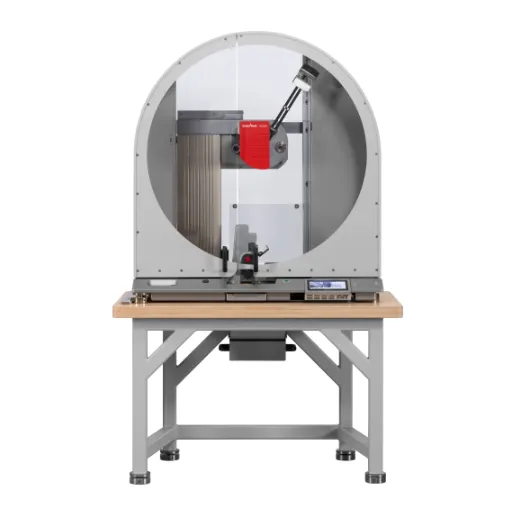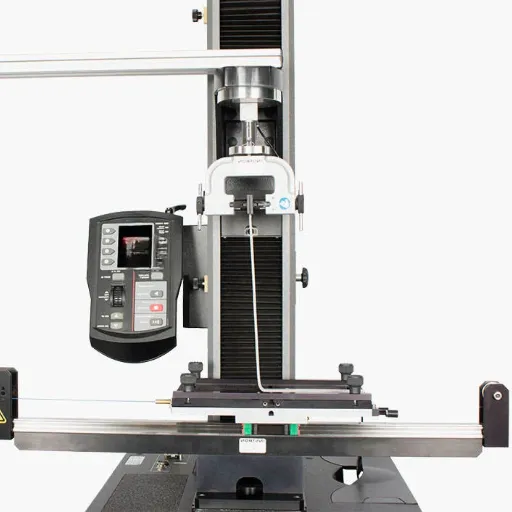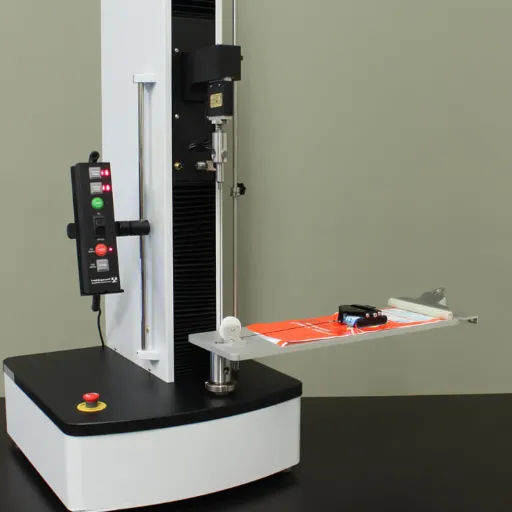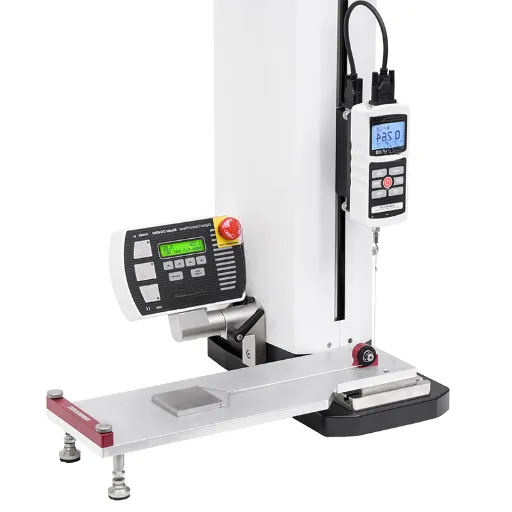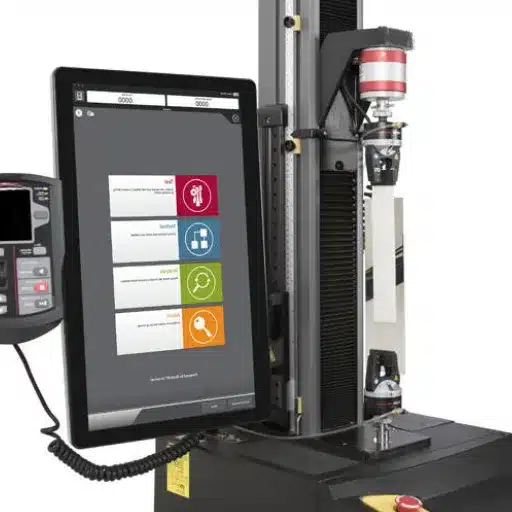Understanding Impact Testing Machines
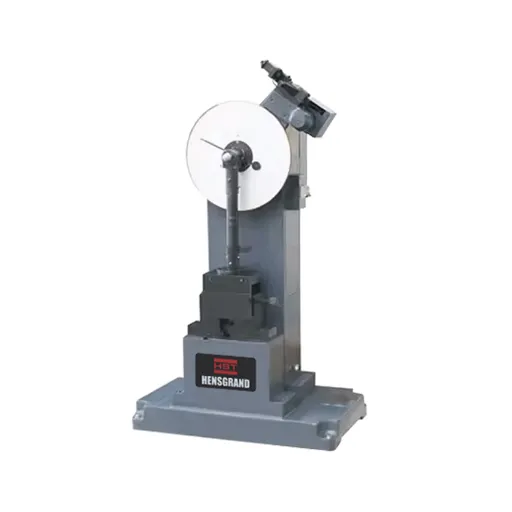
Overview of Impact Testing
Impact testing is a very important evaluation process that is used for assessing the resilience and the impact of sudden forces, shocks, and punctuations on the material. It is used in understanding the performance of the material in case of impact forces, and evaluates the strength, impact, and fracturing behavior of the material. Impact testing evaluates the material’s performance by calculating the impact forces it can endure, and by this, it can be understood how it performs in extreme engineers environment.
Generally, impact testing includes hitting the specimen of the material with a hammer or a pendulum at a fixed speed and evaluating the energy taken during the process. The Charpy and Izod tests is one of the two popular impact tests which measures the energy needed to fracture a notched specimen. These test’s outcome is highly important as it enables one to understand the behavior of the material and guarantee impact safety during the use-cases in the construction, aerospace, and automotive industries.
The advantages of impact testing are manifold. It guides producers in pinpointing materials best-fit for their unique use cases, aids in the creation of products that are safer and have a longer service life, and guarantees adherence to industry certification requirements. Utilizing impact testing, researchers are able to engineer new materials that are designed to endure harsh conditions, promoting innovation in numerous fields. For the most part, impact testing enables the formulation of engineering solutions that are guaranteed to maximize the performance of its components and their reliability.
Types of Impact Test Equipment
Impact test equipment is used to determine the strength, toughness, and durability of materials when subjected to sudden forces or loads. There are numerous kinds of impact test equipment, each of which has a unique function in the evaluation of materials.
- Charpy Testers: Charpy testers permit evaluators to measure the energy absorbed by a notched test piece in order to determine its impact resistance. Analyzers use this equipment to test metals and plastics, especially in industries where components must withstand sudden impacts or low temperatures.
- Drop Weight Testers: Drop weight testers are used to perform heavy impact simulations by dropping asymmetric weights on test pieces. These devices are best suited for testing the impact resistance of materials used in pipelines, automotive parts, or other structural components where there is a risk of sudden impact.
- Pendulum Impact Testers: In order to perform tests, pendulum testers use swinging pendulums to deliver measured energy amounts to the test material. These testers help in analyzing the energy consumed in breaking the specimen and therefore help in analyzing the impact resistance of the material, therefore helping the engineers to better estimate the behavior of the material in actual impact loading scenarios.
In the construction, aerospace, automotive, and manufacturing industries, this equipment is vital in evaluating and certifying materials to be dependable and safe.
Importance of Computer Control in Testing
In today’s world of material evaluation, accuracy, consistency, and effectiveness can only be achieved through computer control. An automated system minimizes material evaluation errors, which in turn enhances the dependability of data and its analysis. This not only enhances the dependability of outcomes but also ensures that the evaluation complies with the necessary standards and methods.
Perhaps the best feature of the system is its computer-controlled testing, which makes it possible to oversee and control sophisticated testing parameters instantly as a result of automation. These systems test materials at different conditions, which is very essential in testing. Testing materials under different conditions is very important in testing materials under safety and specific operational conditions of performance.
Furthermore, the control through computers improves the management and issue of data. Through the automation of the collection, storage, and analysis of data, these materials enable quicker and more detailed evaluations of materials. As such, tests provide analyses materials required to make decisions by the researchers and engineers within a much shorter time and at a lower cost.
Charpy Impact Test Explained
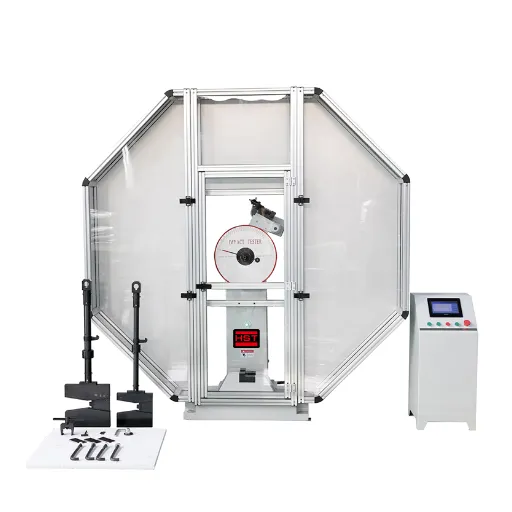
Principle of the Charpy Impact Test
The Charpy Impact Test has the objective of understanding a material’s ability to absorb energy and withstand fractures under an impact. This is a very common test done to metals as it is a very strong indicator on how the material will behave under dynamic loads. The test consists of a pendulum hammer striking a notched specimen. The specimen is supported horizontally and the hammer strikes it at the center, on the notched side. The energy used to break the specimen is measured and is associated with the impact toughness of the material. The energy absorbed is a representation of the material’s resistance to crack propagation under high strain rates. As the test results provide important mechanical properties of materials like brittleness and ductility, the test lies at the core of every safety and durability application. The test enables researchers and engineers to estimate the performance of a material in actual conditions, helping them in choosing the right materials for construction, machinery, and other vital applications.
Charpy vs. Izod Impact Testing
Both the Charpy and Izod impact tests are used to determine a material’s toughness, yet their use and arrangement distinguish them from each other. Impact tests performed on materials are used to calculate the energy a material can absorb, and both Charpy and Izod are impact tests. However, their methods and impact test structures are distinct. The most significant distinction is in the positioning and orientation of the specimen. The Izod test, for instance, holds the specimen as a cantilever beam in a vertical position whereas the Charpy test holds the specimen in a horizontal position on two supports. Furthermore, the orientation of the notch on the specimens is opposite in the two tests as it faces away from the pendulum in the Charpy test, but in the Izod test, it faces the pendulum’s impact point. The results these tests offer for the materials are different, and these two distinct setups are the reason behind it. Testing stress distribution during performance using the two tests is also different.
| Test Type | Specimen Position | Notch Orientation | Primary Application |
|---|---|---|---|
| Charpy Test | Horizontal on two supports | Faces away from pendulum | Construction and energy sectors |
| Izod Test | Vertical cantilever beam | Faces pendulum impact point | Plastics and polymers testing |
As discussed, the tests have their distinct differences, but more importantly, the purpose to which each of these tests is applied. Using the Charpy test in the construction and energy sectors is far more common, especially in the case of materials that require a certain level of fracture resistance. Conversely, the Izod test is implemented in the case of plastics and polymers, specifically for small parts which require impact resistance testing. Knowing the difference helps researchers and engineers in selecting the right test for their goals, thus effectively helping in accurate evaluations of the materials.
Key Standards: ASTM and ISO Compliance
The impact test, including the Izod and Charpy, is a material testing procedure that requires accuracy. Therefore, there needs to be a reliable standard for material testing such as the ASTM and the ISO standards. The ASTM standards (E23 and D256) provide detailed impacts testing standards for Izod and Charpy impact testing. E23 and D256 are important because they provide appropriate measures to achieve similar and reproducible results in different environments.
Likewise, the International Organization for Standardization (ISO) makes use of the other regulatory bodies stipulations for testing procedures. The tests are marked differently, for example, using the ISO 148-1 for Charpy testing and using ISO 180 for Izod impact testing. Having these standards helps in unifying the testing procedures throughout the world, making the results comparable in different regions and sectors.
Meeting these standards means the results are consistent and applicable for engineering purposes. Following the procedures outlined in either the ASTM or ISO standards enables scientists and engineers to evaluate materials’ characteristics with certainty and therefore simplifies the best material choice for an intended use.
Features of the Charpy Impact Tester
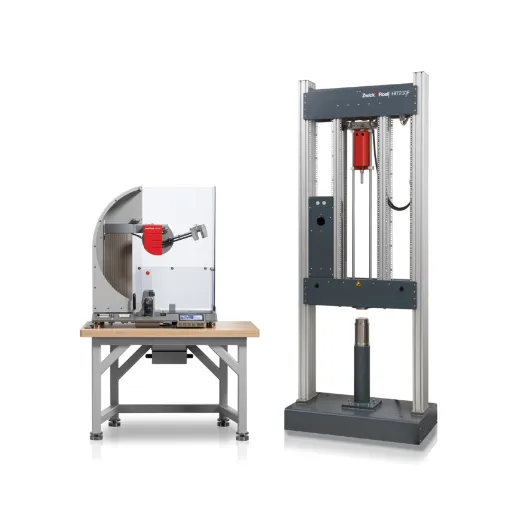
Components of a Charpy Impact Testing Machine
An impact testing machine is a device used to carry out Charpy impact tests. Its most important part is the impact striker, which is a weighted arm that will fall to hit the test piece. The striker is calibrated to a certain energy and will always deliver that energy if unhindered. This allows the calibration to be relative to a standard pendulum energy, which is critical to the concept of reproducibility.
Equally important is the anvil, which holds the test piece firmly in position. The piece, generally a notched rectangular bar, lies on the supports of the anvil so that the striker can hit the notch. The specimen must be properly aligned and firmly gripped to enable reproducibility.
The impact testing machine also has a dial or a digital display that indicates to the user the energy absorbed by the specimen from the impact. This is a measure of the material’s toughness and its fracture resistance at high strain rates. A few other features, such as safety guards and variable pendulum heights, allow for safe operation and flexibility to different testing needs. Taken altogether, these features facilitate accurate testing of materials for use in structural and mechanical design.
Pendulum Mechanism in Impact Testers
The impact resistance of materials is examined by the impact testers with the aid of the pendulum mechanism. To understand how the mechanism functions we must examine the impact testers as a whole. The testers are equipped with a pendulum—a weighted arm—that swings from a designated height an aimed strike a specimen. The energy absorbed and dissipated by the material is used to calculate the impact energy, which is the energy absorbed during the impact. This is the material toughness and is used as an indicator.
To understand the operation of the pendulum, we examine it in the state of being released. At the highest point, the pendulum has stored potential energy, which is converted to kinetic energy on the way down. After reaching the sample, some of the kinetic energy is absorbed by the sample, while the remaining kinetic energy propels the pendulum. The energy expended is used to calculate the fracture energy of the material, which is deducted from the kinetic energy of the sample. This process allows for accurate and repeatable testing, which is the foundation of dynamic materials testing.
Impact testers are also constructed with variably adjustable pendulum heights so that different materials and testing parameters may be accommodated. Such calibrations ensure the impact energy will be appropriate for the test specimen, resulting in equipment protection and valid test results. Together with protective devices and exact calibration, these aspects of the pendulum mechanism are integral in safeguarding reliable testing of materials in the manufacturing and investigation fields.
Advantages of Automated Testing Systems
An automated test system can carry out tests much faster than a person. This is especially useful when dealing with monotonous and repetitive testing. When tests are completed in a shorter time, it aids the assembly and other production processes to function well and reduces production and operational costs.
Automated test systems, for one, do not fluctuate in their performance. This means the test system does the set task in exactly the same way it did before. This is beneficial for tests where human variability may hinder the results. It is crucial for tests from the standpoint of quality control and research to be accurate and reproducible. Automated test systems can implement testing parameters accurately and with ease. This is beneficial for tests that may require very stringent or very relaxed parameters to be met for different materials with little deviation.
Moreover, these systems refine test data gathering as well as its assessment. A large number of systems come with software to capture and store test data in an organized manner as the testing proceeds, making data tracking effortless. This feature makes it easy to take remedial steps, since the responsible personnel can promptly evaluate patterns, spot deviations, and ensure compliance to quality standards through detailed and reliable documentation. As such, automated systems are essential for elevating output while ensuring reliability in testing.
Applications of Charpy Impact Testing

Industries Utilizing Impact Testing
Charpy impact testing is performed in a wide range of industries to confirm reliability and safety of materials and their parts. Notably, construction, automotive, aerospace, and energy sectors heavily depend on such testing. These industries are focused on the material’s ability to perform under dynamic stress, and impact testing is crucial to understand the material’s toughness and impact fracture characteristics.
In construction, materials for construction like steel and reinforced composites are tested to confirm their ability to withstand abrupt impacts or even extreme environmental conditions. This evaluation is necessary for the safety of buildings and bridges, as well as other infrastructure.
In a similar fashion, impact testing is crucial for the automotive and aerospace industries to verify the strength of their parts in the event of a crash or under high-stress conditions. This verifies the compliance of the vehicle and aircraft structures and materials with safety and performance standards. Impact testing is also used in the energy sector for pipelines, wind turbines, and power plant materials, in verification of safety and efficiency during operation under different conditions.
Role in Material Selection and Quality Control
Impact test is a concept familiar to construction engineers. Materials used on a construction project must go through impact test to determine their durability and impact resistance levels. During construction, impact tests are vital because their results guarantee the use of materials that will construct a strong and sturdy structure.
In the quality control process, conducting impact tests is essential for ensuring the materials to be used in production are free from defects. Materials that are subjected to a certain degree of impact forces and tested for their reactions are easier to assess for manufacturers. This makes it possible to eliminate the chances of failures in the next product. In this way, chances of failure are minimized, and there is easier adherence to compliance with set industry norms and laws.
In addition, impact test results allow decision-makers to perform a materials evaluation in a more fair manner. Selecting materials that comply with project specifications at an acceptable cost, weight, and durability are easier to obtain from these materials tests conducted. The impact test yields the material strength data and usable fracture data of the material. Such comparison capabilities enable effective decision-making. Such testing leads to designs that are more efficient and safer in many industries.
Impact on Safety Standards and Compliance
Across multiple sectors, impact tests are vital for upholding and enhancing safety standards. By way of a brief example, impact tests give us insight into how strong a material is, how tough it is, and how it behaves when it fractures. Consequently, impact tests ensure every element passes the safety tests. This is important in mitigating the risks associated with impact–such as accidents, injuries, or even death–that come as a result of failing to meet safety standards.
Often, standards organisations draw on the results of impact tests when setting parameters for the use of materials in safety-critical applications. Consider, for example, the construction, aerospace, and automotive industries—these sectors heavily rely on impact tests to ensure their materials perform well even under the most stringent conditions. Adhering to these standards is a matter of compliance, but also of continuing the relationship of trust between producers, authorities, and consumers.
Moreover, impact test data strengthens the design process, allowing for safer and more radical engineering solutions. Safer products and safer designs enhance reliability. Industries embrace new challenges, and in doing so, adapt updated materials and new testing procedures that still ensure compliance with safety standards. This enables compliance and encourages innovation.
Recent Advancements in Impact Testing Technology

Developments in Pendulum Impact Testing Techniques
Technological advancements in pendulum impact testing have aimed largely at maintaining or increasing the accuracy, efficiency, and consistency of the results. Current testing mechanisms now include the use of high-precision sensors and digital analysis to evaluate and quantify force, impact energy, and deformation with minimal error. Such developments not only help in the elimination of human error but also enable the capture of detailed, quality data that helps in product design enhancement and safety verification.
Automation is one of the major impacts in the innovation of testing apparatus. Automated machines can take care of sample positioning, conduct the impact testing, and deliver the results in a swift manner. Not only does this improve speed, but it also maintains uniform testing standards, which is crucial for obtaining dependable and reproducible results on a series of samples.
Furthermore, enhancements in software have evolved the data analysis in pendulum impact testing. Advanced software offers the capabilities of receiving feedback instantly, result visualization intuitively, and conducting simulations of higher complexity. Such capabilities enable the engineers to take remedial actions much earlier in the design cycle, thereby guaranteeing the compliance of the materials and the products with the applicable safety and performance standards.
Integration of Digital Technologies
The use of digital technology has completely changed the way pendulum impact tests are carried out by increasing accuracy, eliminating mistakes, and simplifying the workflow. The use of advanced sensors and the automation of data gathering have produced a more dependable yet faster testing system. Such systems are able to capture and evaluate even the minutest differences in test results, thereby giving a deeper insight into the behaviour of materials when subjected to impact.
The inclusion of machine learning algorithms for pattern detection and predictive modelling is a milestone in the evolution of impact testing. The tools in question are tremendously useful when dealing with large amounts of data, as is the norm with impact testing, since they can pick out relevant trends and outliers that would be missed with the naked eye. Such foresight allows engineers to tackle problems well in advance, thereby greatly reducing the likelihood of materials failing and slashing maintenance costs.
Moreover, the use of the cloud has made it easier for teams to collaborate and share information. Test data and simulations can be viewed immediately, regardless of the outside world. With this level of availability, different units can interact, which leads to faster decisions and refined design changes. In conjunction with each other, these digital solutions have not only made pendulum impact tests easier but are also improving the accuracy and chasing efficiency in material testing procedures.
Future Trends in Impact Test Equipment
The future cutting-impact test equipment developments are rooted deeply in intelligent technologies and further automation. Procedures are being optimized, and human and system errors are being minimized, thanks to automated test systems. Devices are being made more precise with minimal devices and manual intervention by utilizing artificial intelligence and robotics.
There is also increasing focus on data integration and digital connectivity. Impact test equipment is being developed to integrate with other data management systems and enable real-time analysis and reporting. This connectivity improves result sharing for better collaboration. It speeds up product development as well as informed decision-making. Cloud-based procurement is enabling users to store and retrieve large volumes of data for analysis.
Testing equipment is also being developed with a view to environmental sustainability in mind. Testing equipment manufacturers are employing the use of energy-saving devices and looking into ways of minimizing waste during testing. This not only aids companies in cutting down on their expenditures but also complies with sustainable development initiatives on a global scale. These developments seem to suggest that in the near future, impact test machinery will be developed not only to be faster and smarter but also to stricter test equipment manufacturers will be required to uphold eco-friendly designs.
Frequently Asked Questions (FAQ)
Q: What is a computerized impact testing machine?
A: A computerized impact testing machine specifically checks the impact resistance of metals and plastics. The machine’s computer takes charge and runs the Charpy and Izod tests on the specimen, calculating the energy the specimen absorbs in impact resistance testing.
Q: What is the process of a Charpy Impact Test?
A: The Charpy impact test is performed by using a pendulum hammer to hit a notched specimen, while the impact test machine records the energy absorbed in joules. This test is most of the times done using the ASTM E23 standard to check the impact strength and resistance of a material.
Q: What differences do the Charpy and Izod tests have?
A: Both the Charpy and Izod tests are adopted to check the impact resistance, and differ only in specimen orientation; the type of notch; and approach. The Charpy test uses a horizontal specimen and U-shaped notch whereas the Izod test uses a vertical specimen and V-shaped notch. Both tests give information on the energy absorbed during impact.
Q: What materials can be tested using an impact testing machine?
A: The impact testing machine can test a variety of materials, including metals like steel and plastics. The machine determines the anti-impact capability of these materials when subjected to dynamic loads.
Q: What is the significance of the energy absorbed during impact tests?
A: The impact energy absorbed, in joules, shows the threshold of energy a material can take in before breaking. Such evaluation is critical in assessing the impact resistance and the general durability of a material in an environment where a sudden shock is likely to be experienced.
Q: How is Impact Testing Performed Using Drop Weight Testers?
A: Using the DWT-1800 impact testing machine as an example, drop weight testers operate by using a predetermined drop height to depress a test specimen with a falling mass. The resulting impact is controlled and the stress induced in the material can be assessed for impact strength and energy absorption.
Q: What are the testing standards for impact testing machines?
A: For impact testing machines, the testing standards such as ASTM E23 and ISO must be adhered to. As their names imply, these standards guarantee the test results can be trusted and are consistent, as well as enable the comparison of the impact resistance of diverse materials.
Q: What are the criteria of computer control in impact testing machines?
A: The computer control of impact testing machines improves test accuracy, enhances data collection, and improves the overall testing process. It provides the ability to automatically administer testing protocols, instantaneously capture and analyze impact measurement data, and conveniently produce performance evaluation reports of materials subjected to impact testing.
Q: Is it Possible to Use an Impact Testing Machine on Both Plastics and Metals?
A: Impact testing machines can be used on plastics and metals for testing purposes. However, it is also possible that other test methods like Charpy and Izod may be chosen depending on the kind of material and the particular characteristics wanted to be investigated.
References
-
Impact Testers & Charpy Impact Testers – ZwickRoell
Provides details on various impact testing machines, including computerized options for plastics and metals. -
DWT-1800 Computer Controlled Drop Weight Impact Testing Machine – NextGen
Focuses on the DWT-1800, a computerized impact testing machine for ferritic steel. -
Computerised Izod / Charpy Impact Tester – International Equipments
Describes computerized Izod and Charpy impact testers for plastics, compliant with ASTM and ISO standards. -
Drop Weight Impact Testing Machine – Instron
Explains the functionality and applications of drop weight impact testing machines.

